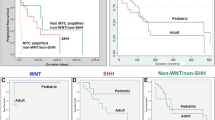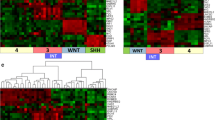Abstract
Medulloblastoma (MB) is the most common malignant brain tumor in childhood. The 5 year disease-free survival rate is rather low. There is a consensus that MB can be divided into at least four clinically, transcriptionally, and genetically distinct molecular variants, being designated as wingless (WNT), sonic hedgehog (SHH), Group 3 and Group 4. It poses a great challenge to the design of therapeutic strategy for MB patients. Intensive clinical intervention, including high dose radiotherapy, is commonly used in treatment of high risk MB, most of which are considered to be Group 3 patients. But such intensive therapy should be avoided to protect neurologic function of patients in the lower risk WNT group. In present study, MB subgroup assignment in formalin-fixed paraffin embedded (FFPE) specimens from 45 Chinese patients were performed by Nanostring platform using 22 well-known signature genes. Based on comparative expression profiles of miRNA real-time PCR microarray in MB cells with and without treatment of demethylation reagent, as well as MSP assay, miR-449a was demonstrated to be significantly silenced by aberrant DNA methylation in tumor cells. Real-time PCR showed that expression level of miR-449a in WNT group was significantly different from other subgroups, although it was down-regulated in most of the MB samples. In conclusion, current study demonstrates for the first time the feasibility of using the Nanostring assay for subgrouping of MBs in Chinese patients. In addition, MiR-449a, a candidate tumor suppressor regulated by hypermethylation, is a novel potential diagnostic marker for WNT group of MBs.




Similar content being viewed by others
References
Gajjar A, Chintagumpala M, Ashley D, Kellie S, Kun LE, Merchant TE et al (2006) Risk-adapted craniospinal radiotherapy followed by high-dose chemotherapy and stem-cell rescue in children with newly diagnosed medulloblastoma (St Jude Medulloblastoma-96): long-term results from a prospective, multicentre trial. Lancet Oncol 7:813–820
Packer RJ, Gajjar A, Vezina G, Rorke-Adams L, Burger PC, Robertson PL et al (2006) Phase III study of craniospinal radiation therapy followed by adjuvant chemotherapy for newly diagnosed average-risk medulloblastoma. J Clin Oncol 24:4202–4208
Louis DN, Ohgaki H, Wiestler OD, Cavenee WK, Burger PC, Jouvet A et al (2007) The 2007 WHO classification of tumours of the central nervous system. Acta Neuropathol (Berl) 114:97–109
Northcott PA, Korshunov A, Witt H, Hielscher T, Eberhart CG, Mack S et al (2011) Medulloblastoma comprises four distinct molecular variants. J Clin Oncol 29:1408–1414
Northcott PA, Shih DJ, Remke M, Cho YJ, Kool M, Hawkins C et al (2012) Rapid, reliable, and reproducible molecular sub-grouping of clinical medulloblastoma samples. Acta Neuropathol (Berl) 123:615–626
Beard RE, Abate-Daga D, Rosati SF, Zheng Z, Wunderlich JR, Rosenberg SA et al (2013) Gene expression profiling using nanostring digital RNA counting to identify potential target antigens for melanoma immunotherapy. Clin Cancer Res 19:4941–4950
Kim VN (2005) MicroRNA biogenesis: coordinated cropping and dicing. Nat Rev Mol Cell Biol 6:376–385
Calin GA, Dumitru CD, Shimizu M, Bichi R, Zupo S, Noch E et al (2002) Frequent deletions and down-regulation of micro-RNA genes miR15 and miR16 at 13q14 in chronic lymphocytic leukemia. Proc Natl Acad Sci USA 99:15524–15529
Calin GA, Croce CM (2006) MicroRNA signatures in human cancers. Nat Rev Cancer 6:857–866
Garzon R, Fabbri M, Cimmino A, Calin GA, Croce CM (2006) MicroRNA expression and function in cancer. Trends Mol Med 12:580–587
Sarkar S, Dubaybo H, Ali S, Goncalves P, Kollepara SL, Sethi S et al (2013) Down-regulation of miR-221 inhibits proliferation of pancreatic cancer cells through up-regulation of PTEN, p27(kip1), p57(kip2), and PUMA. Am J Cancer Res 3:465–477
Li H, Yu G, Shi R, Lang B, Chen X, Xia D et al (2014) Cisplatin-induced epigenetic activation of miR-34a sensitizes bladder cancer cells to chemotherapy. Mol Cancer 13:8
Du L, Zhao Z, Ma X, Hsiao TH, Chen Y, Young E et al (2014) miR-93-directed downregulation of DAB2 defines a novel oncogenic pathway in lung cancer. Oncogene 33:4307–4315
Zhao Z, Ma X, Sung D, Li M, Kosti A, Lin G et al (2015) microRNA-449a functions as a tumor suppressor in neuroblastoma through inducing cell differentiation and cell cycle arrest. RNA Biol 12:538–554
Genovesi LA, Carter KW, Gottardo NG, Giles KM, Dallas PB (2011) Integrated analysis of miRNA and mRNA expression in childhood medulloblastoma compared with neural stem cells. PloS One 6:e23935
Venkataraman S, Birks DK, Balakrishnan I, Alimova I, Harris PS, Patel PR et al (2013) MicroRNA 218 acts as a tumor suppressor by targeting multiple cancer phenotype-associated genes in medulloblastoma. J Biol Chem 288:1918–1928
Ferretti E, De Smaele E, Po A, Di Marcotullio L, Tosi E, Espinola MS et al (2009) MicroRNA profiling in human medulloblastoma. Int J Cancer 124:568–577
Miska EA (2005) How microRNAs control cell division, differentiation and death. Current Opin Genet Dev 15:563–568
Yang F, Bi J, Xue X, Zheng L, Zhi K, Hua J et al (2012) Up-regulated long non-coding RNA H19 contributes to proliferation of gastric cancer cells. FEBS J 279:3159–3165
Pierson J, Hostager B, Fan R, Vibhakar R (2008) Regulation of cyclin dependent kinase 6 by microRNA 124 in medulloblastoma. J Neurooncol 90:1–7
Shalaby T, Fiaschetti G, Baumgartner M, Grotzer MA (2014) MicroRNA signatures as biomarkers and therapeutic target for CNS embryonal tumors: the pros and the cons. Int J Mol Sci 15:21554–21586
Northcott PA, Fernandez LA, Hagan JP, Ellison DW, Grajkowska W, Gillespie Y et al (2009) The miR-17/92 polycistron is up-regulated in sonic hedgehog-driven medulloblastomas and induced by N-myc in sonic hedgehog-treated cerebellar neural precursors. Cancer Res 69:3249–3255
Weeraratne SD, Amani V, Teider N, Pierre-Francois J, Winter D, Kye MJ et al (2012) Pleiotropic effects of miR-183 ~96~182 converge to regulate cell survival, proliferation and migration in medulloblastoma. Acta Neuropathol (Berl) 123:539–552
Chang Q, Pang JC, Li KK, Poon WS, Zhou L, Ng HK (2005) Promoter hypermethylation profile of RASSF1A, FHIT, and sFRP1 in intracranial primitive neuroectodermal tumors. Hum Pathol 36:1265–1272
Pang JC, Chang Q, Chung YF, Teo JG, Poon WS, Zhou LF et al (2005) Epigenetic inactivation of DLC-1 in supratentorial primitive neuroectodermal tumor. Hum Pathol 36:36–43
Shao LW, Pan Y, Qi XL, Li YX, Ma XL, Yi WN et al (2016) ATRX loss in adult supratentorial diffuse astrocytomas correlates with p53 over expression and IDH1 mutation and predicts better outcome in p53 accumulated patients. Histol Histopathol 31:103–114
Zhou X, Zhu W, Li H, Wen W, Cheng W, Wang F et al (2015) Diagnostic value of a plasma microRNA signature in gastric cancer: a microRNA expression analysis. Sci Rep 5:11251
Yao Y, Ma J, Xue Y, Wang P, Li Z, Li Z et al (2015) MiR-449a exerts tumor-suppressive functions in human glioblastoma by targeting Myc-associated zinc-finger protein. Mol Oncol 9:640–656
Yang X, Feng M, Jiang X, Wu Z, Li Z, Aau M et al (2009) miR-449a and miR-449b are direct transcriptional targets of E2F1 and negatively regulate pRb-E2F1 activity through a feedback loop by targeting CDK6 and CDC25A. Genes Dev 23:2388–2393
Chen J, Zhou J, Chen X, Yang B, Wang D, Yang P et al (2015) miRNA-449a is downregulated in osteosarcoma and promotes cell apoptosis by targeting BCL2. Tumour Biol 36:8221–8229
Yuan JM, Shi XJ, Sun P, Liu JX, Wang W, Li M et al (2015) Downregulation of cell cycle-related proteins in ovarian cancer line and cell cycle arrest induced by microRNA. Int J Clin Exp Med 8:18476–18481
Chen SP, Liu BX, Xu J, Pei XF, Liao YJ, Yuan F et al (2015) MiR-449a suppresses the epithelial-mesenchymal transition and metastasis of hepatocellular carcinoma by multiple targets. BMC Cancer 15:706
Shi W, Bruce J, Lee M, Yue S, Rowe M, Pintilie M et al (2016) MiR-449a promotes breast cancer progression by targeting CRIP2. Oncotarget.doi:10.18632/oncotarget.7753
Chen S, Dai Y, Zhang X, Jin D, Li X, Zhang Y (2014) Increased miR-449a expression in colorectal carcinoma tissues is inversely correlated with serum carcinoembryonic antigen. Oncol Lett 7:568–572
You J, Zhang Y, Li Y, Fang N, Liu B, Zu L et al (2015) MiR-449a suppresses cell invasion by inhibiting MAP2K1 in non-small cell lung cancer. Am J Cancer Res 5:2730–2744
Reis PP, Waldron L, Goswami RS, Xu W, Xuan Y, Perez-Ordonez B et al (2011) mRNA transcript quantification in archival samples using multiplexed, color-coded probes. BMC Biotechnol 11:46
Geiss GK, Bumgarner RE, Birditt B, Dahl T, Dowidar N, Dunaway DL et al (2008) Direct multiplexed measurement of gene expression with color-coded probe pairs. Nat Biotechnol 26:317–325
Cho YJ, Tsherniak A, Tamayo P, Santagata S, Ligon A, Greulich H et al (2011) Integrative genomic analysis of medulloblastoma identifies a molecular subgroup that drives poor clinical outcome. J Clin Oncol 29:1424–1430
Kool M, Koster J, Bunt J, Hasselt NE, Lakeman A, van Sluis P et al (2008) Integrated genomics identifies five medulloblastoma subtypes with distinct genetic profiles, pathway signatures and clinicopathological features. PloS One 3:e3088
Gupta T, Shirsat N, Jalali R (2015) Molecular subgrouping of medulloblastoma: impact upon research and clinical practice. Curr Pediatr Rev 11:106–119
Gokhale A, Kunder R, Goel A, Sarin R, Moiyadi A, Shenoy A et al (2010) Distinctive microRNA signature of medulloblastomas associated with the WNT signaling pathway. J Cancer Res Ther 6:521–529
Iliopoulos D, Bimpaki EI, Nesterova M, Stratakis CA (2009) MicroRNA signature of primary pigmented nodular adrenocortical disease: clinical correlations and regulation of Wnt signaling. Cancer Res 69:3278–3282
Curran EK, Sainani KL, Le GM, Propp JM, Fisher PG (2009) Gender affects survival for medulloblastoma only in older children and adults: a study from the surveillance epidemiology and end results registry. Pediatr Blood Cancer 52:60–64
Acknowledgments
This work was supported by the National Natural Science Foundation of China (Grant No. 81101900) and the Clinicopathologic Innovation Fund from Peking University Third Hospital, Peking University Health Science Center to Qing Chang, MD., Ph.D.
Author information
Authors and Affiliations
Corresponding author
Ethics declarations
Conflict of interest
None.
Rights and permissions
About this article
Cite this article
Li, Y., Jiang, T., Shao, L. et al. Mir-449a, a potential diagnostic biomarker for WNT group of medulloblastoma. J Neurooncol 129, 423–431 (2016). https://doi.org/10.1007/s11060-016-2213-y
Received:
Accepted:
Published:
Issue Date:
DOI: https://doi.org/10.1007/s11060-016-2213-y




